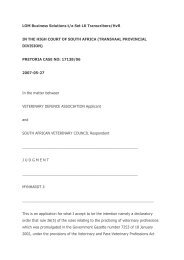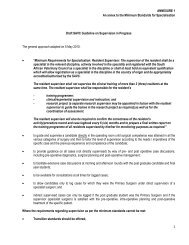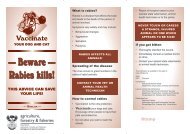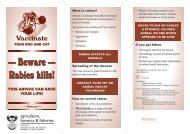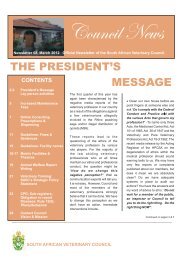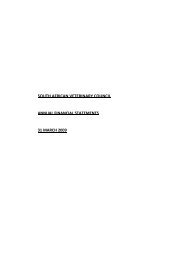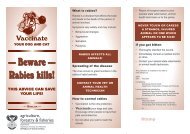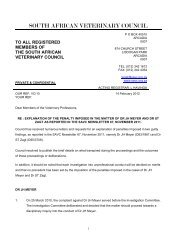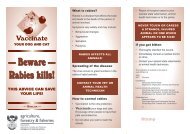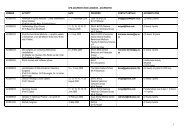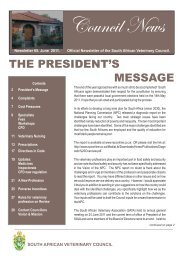Rabies Guide 2010.pdf - the South African Veterinary Council
Rabies Guide 2010.pdf - the South African Veterinary Council
Rabies Guide 2010.pdf - the South African Veterinary Council
Create successful ePaper yourself
Turn your PDF publications into a flip-book with our unique Google optimized e-Paper software.
Plate 17: Terminal rabies can be confused with many o<strong>the</strong>r animal diseases, such as corridor disease,<br />
cerebral redwater and heartwater<br />
Prevention of <strong>Rabies</strong><br />
Pre-exposure vaccination<br />
A number of recently developed, highly-effective,<br />
<strong>the</strong>rmostable, inactivated vaccines are available in<br />
<strong>South</strong> Africa for veterinary use. The duration of<br />
immunity conferred varies from one to three years.<br />
Most veterinary vaccines are only registered for use<br />
in specific species, for example dogs. Although <strong>the</strong>re<br />
are no safety limitations to <strong>the</strong>ir use, <strong>the</strong>ir efficiency<br />
in o<strong>the</strong>r species, for example mongoose, is not<br />
guaranteed. All rabies vaccines registered for human<br />
and animal use must conform to established potency<br />
standards. A minimum antigenic potency of 2,5 IU<br />
per dose is mandatory. 41<br />
The vaccines may be used in young pups, but <strong>the</strong>y<br />
must be boosted at three months of age and again<br />
within <strong>the</strong> following year. Revaccination must be<br />
carried out every three years <strong>the</strong>reafter. Cattle and<br />
sheep may be vaccinated annually or every two to<br />
three years, depending on <strong>the</strong> vaccine manufacturer’s<br />
instructions. Some farmers inoculate <strong>the</strong>ir herds<br />
every year in jackal and dog rabies endemic areas<br />
with <strong>the</strong>se inexpensive vaccines as <strong>the</strong>y consider this<br />
practice to be economically sound.<br />
Following an outbreak in domestic livestock,<br />
vaccination of animals without visible bite wounds is<br />
strongly recommended. In cases where bite wounds<br />
are visible, or <strong>the</strong>re is direct evidence that an animal<br />
was bitten, <strong>the</strong> animal should immediately be isolated<br />
and destroyed.<br />
Post-exposure prophylaxis<br />
Post-exposure prophylaxis (PEP) of bite-contact<br />
unvaccinated carnivores, including dogs and cats,<br />
is not recommended in <strong>South</strong> Africa. Preliminary<br />
reports indicate that antibodies in <strong>the</strong> form of<br />
antirabies immunoglobulin (RIG) in combination<br />
with vaccine yielded poor results. 42 The use of PEP in<br />
animals is not without risk and is not recommended<br />
for use in animals in <strong>South</strong> Africa.<br />
26



